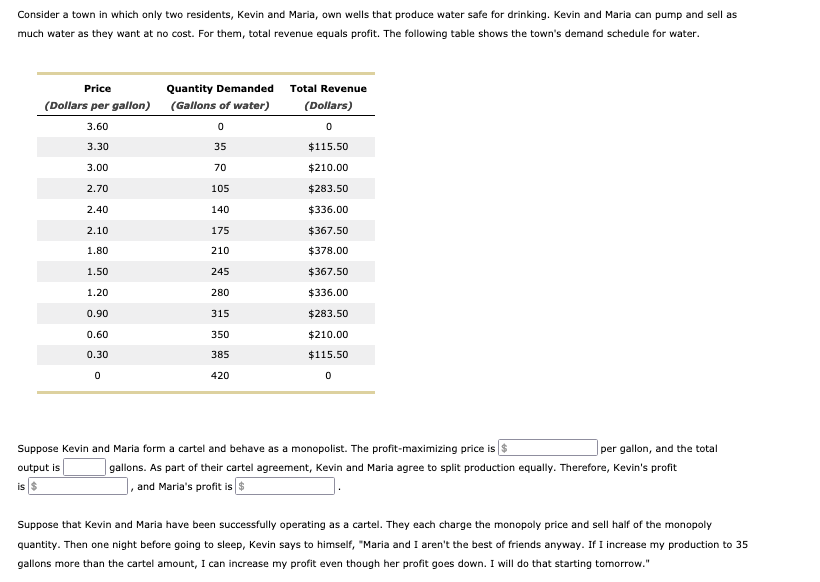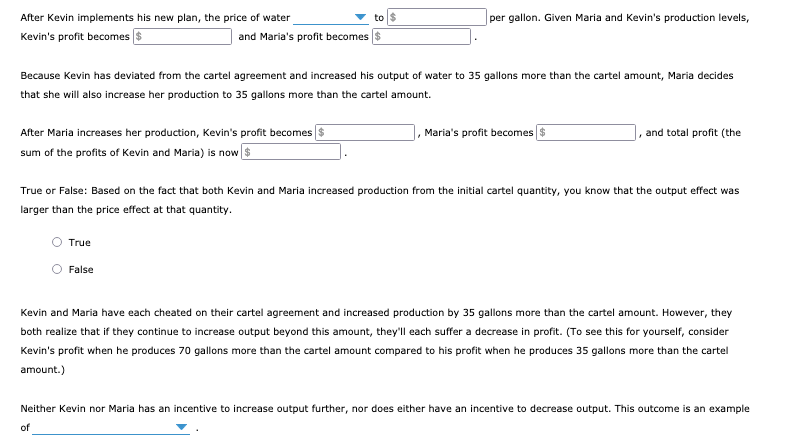140 $336.00 175 $367.50 210 $378.00 245 $367.50 280 $336.00 315 $283.50 350 $210.00 385 $115.50 0 420 el and behave as a monopolist. The profit-maximizing price is $ per gallon, and the total their cartel agreement, Kevin and Maria agree to split production equally. Therefore, Kevin's profit rofit is $ een successfully operating as a cartel. They each charge the monopoly price and sell half of the monopoly to sleep, Kevin says to himself, "Maria and I aren't the best of friends anyway. If I increase my production to 35 I can increase my profit even though her profit goes down. I will do that starting tomorrow."
140 $336.00 175 $367.50 210 $378.00 245 $367.50 280 $336.00 315 $283.50 350 $210.00 385 $115.50 0 420 el and behave as a monopolist. The profit-maximizing price is $ per gallon, and the total their cartel agreement, Kevin and Maria agree to split production equally. Therefore, Kevin's profit rofit is $ een successfully operating as a cartel. They each charge the monopoly price and sell half of the monopoly to sleep, Kevin says to himself, "Maria and I aren't the best of friends anyway. If I increase my production to 35 I can increase my profit even though her profit goes down. I will do that starting tomorrow."
Managerial Economics: Applications, Strategies and Tactics (MindTap Course List)
14th Edition
ISBN:9781305506381
Author:James R. McGuigan, R. Charles Moyer, Frederick H.deB. Harris
Publisher:James R. McGuigan, R. Charles Moyer, Frederick H.deB. Harris
Chapter3: Demand Analysis
Section: Chapter Questions
Problem 10E
Related questions
Question
7

Transcribed Image Text:Consider a town in which only two residents, Kevin and Maria, own wells that produce water safe for drinking. Kevin and Maria can pump and sell as
much water as they want at no cost. For them, total revenue equals profit. The following table shows the town's demand schedule for water.
Price
Quantity Demanded
(Gallons of water)
Total Revenue
(Dollars)
(Dollars per gallon)
3.60
0
0
3.30
35
$115.50
3.00
70
$210.00
2.70
105
$283.50
2.40
140
$336.00
2.10
175
67.50
1.80
210
$378.00
1.50
245
$367.50
1.20
280
$336.00
0.90
315
$283.50
0.60
350
$210.00
0.30
385
$115.50
0
420
0
Suppose Kevin and Maria form a cartel and behave as a monopolist. The profit-maximizing price is $
output is
per gallon, and the total
gallons. As part of their cartel agreement, Kevin and Maria agree to split production equally. Therefore, Kevin's profit
and Maria's profit is $
is $
Suppose that Kevin and Maria have been successfully operating as a cartel. They each charge the monopoly price and sell half of the monopoly
quantity. Then one night before going to sleep, Kevin says to himself, "Maria and I aren't the best of friends anyway. If I increase my production to 35
gallons more than the cartel amount, I can increase my profit even though her profit goes down. I will do that starting tomorrow."

Transcribed Image Text:to $
per gallon. Given Maria and Kevin's production levels,
After Kevin implements his new plan, the price of water
Kevin's profit becomes $
and Maria's profit becomes
Because Kevin has deviated from the cartel agreement and increased his output of water to 35 gallons more than the cartel amount, Maria decides
that she will also increase her production to 35 gallons more than the cartel amount.
After Maria increases her production, Kevin's profit becomes $
Maria's profit becomes $
, and total profit (the
sum of the profits of Kevin and Maria) is now $
True or False: Based on the fact that both Kevin and Maria increased production from the initial cartel quantity, you know that the output effect was
larger than the price effect at that quantity.
True
False
Kevin and Maria have each cheated on their cartel agreement and increased production by 35 gallons more than the cartel amount. However, they
both realize that if they continue to increase output beyond this amount, they'll each suffer a decrease in profit. (To see this for yourself, consider
Kevin's profit when he produces 70 gallons more than the cartel amount compared to his profit when he produces 35 gallons more than the cartel
amount.)
Neither Kevin nor Maria has an incentive to increase output further, nor does either have an incentive to decrease output. This outcome is an example
of
Expert Solution
This question has been solved!
Explore an expertly crafted, step-by-step solution for a thorough understanding of key concepts.
Step by step
Solved in 2 steps

Knowledge Booster
Learn more about
Need a deep-dive on the concept behind this application? Look no further. Learn more about this topic, economics and related others by exploring similar questions and additional content below.Recommended textbooks for you

Managerial Economics: Applications, Strategies an…
Economics
ISBN:
9781305506381
Author:
James R. McGuigan, R. Charles Moyer, Frederick H.deB. Harris
Publisher:
Cengage Learning

Managerial Economics: A Problem Solving Approach
Economics
ISBN:
9781337106665
Author:
Luke M. Froeb, Brian T. McCann, Michael R. Ward, Mike Shor
Publisher:
Cengage Learning

Exploring Economics
Economics
ISBN:
9781544336329
Author:
Robert L. Sexton
Publisher:
SAGE Publications, Inc

Managerial Economics: Applications, Strategies an…
Economics
ISBN:
9781305506381
Author:
James R. McGuigan, R. Charles Moyer, Frederick H.deB. Harris
Publisher:
Cengage Learning

Managerial Economics: A Problem Solving Approach
Economics
ISBN:
9781337106665
Author:
Luke M. Froeb, Brian T. McCann, Michael R. Ward, Mike Shor
Publisher:
Cengage Learning

Exploring Economics
Economics
ISBN:
9781544336329
Author:
Robert L. Sexton
Publisher:
SAGE Publications, Inc

